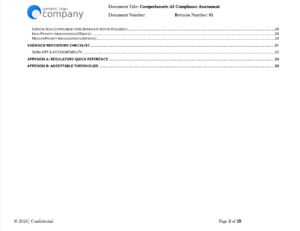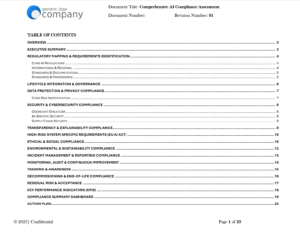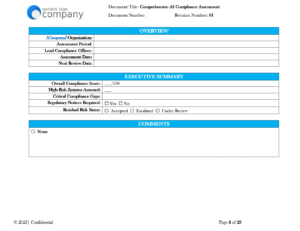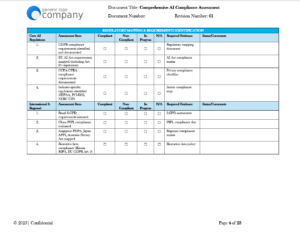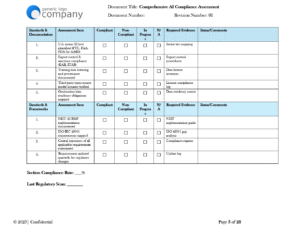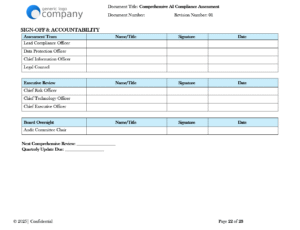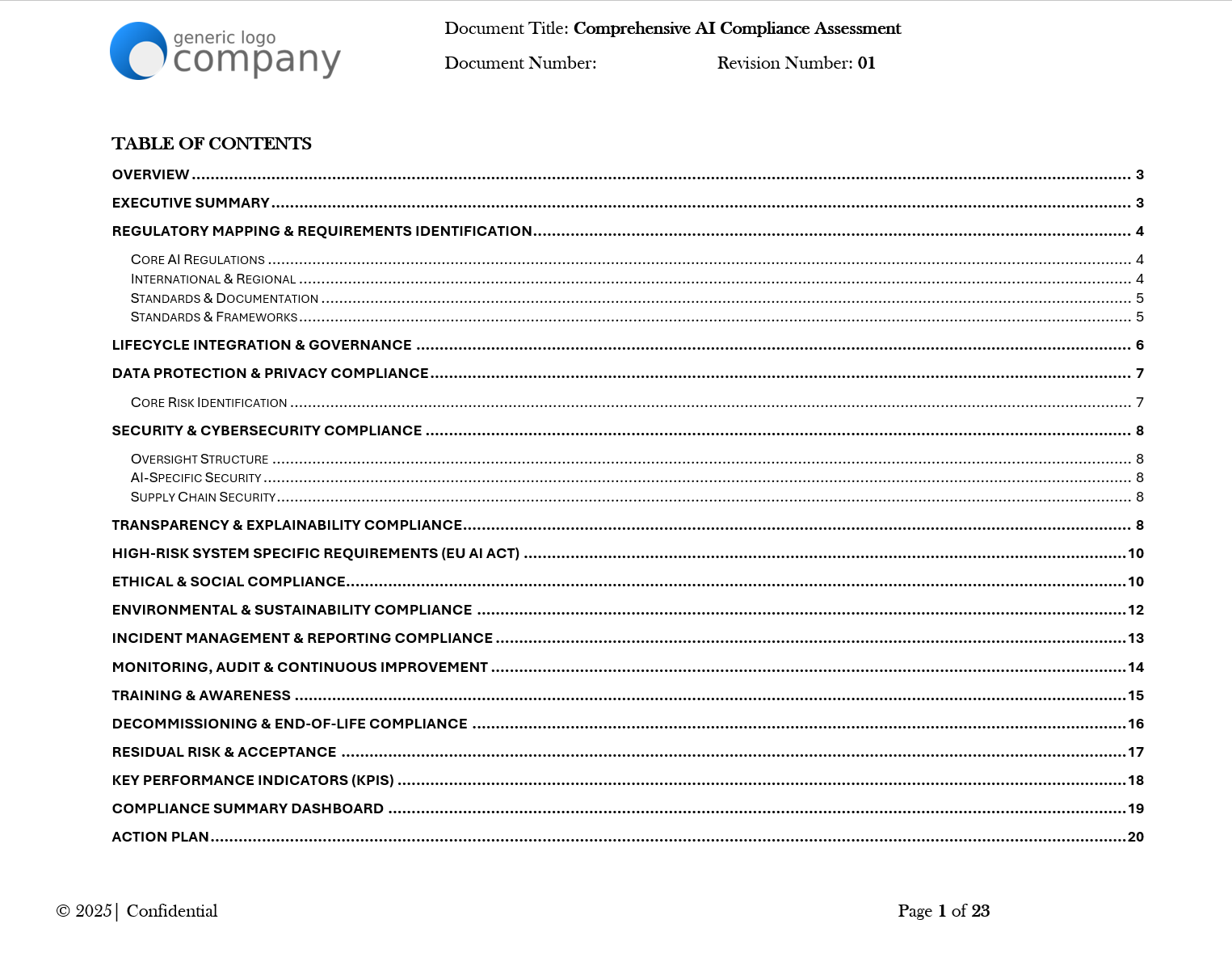
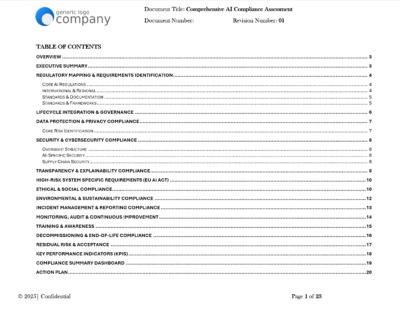
- Version
- Download
- File Size 0.00 KB
- File Count 0
- Create Date August 24, 2025
- Last Updated August 24, 2025
Comprehensive AI Compliance Assessment Template
Evaluate, score, and monitor your organization’s AI compliance against global regulations, standards, and frameworks.
Check Your AI Compliance: [Download Now]
Conversion Layer
Intro:
AI compliance is no longer optional. Organizations face a growing web of regulatory, ethical, and security requirements. This Comprehensive AI Compliance Assessment Template provides a structured, audit-ready framework to identify gaps, document evidence, and build an actionable compliance roadmap.
Key Benefits:
-
✅ Global Coverage: EU AI Act, GDPR, CCPA/CPRA, HIPAA, PIPL, LGPD, PDPA, APPI.
-
✅ Standards Alignment: NIST AI RMF, ISO/IEC 42001, ISO/IEC 23894, ISO/IEC 27001.
-
✅ Audit-Ready: Includes dashboards, KPIs, evidence checklists, and sign-off pages.
-
✅ Risk Management: Addresses privacy, security, explainability, bias, supply chain, and high-risk systems.
-
✅ Actionable Outputs: Prioritized action plan with critical, high, and medium-priority fixes.
Who Uses This?
Compliance officers, risk managers, auditors, and governance committees preparing for AI Act conformity assessments, ISO certification, or internal AI risk reviews.
SEO Depth Layer
Why This Matters
The EU AI Act and other global laws impose strict obligations for high-risk AI systems. Without a structured assessment, organizations risk fines, regulatory sanctions, and reputational damage. This template gives you a complete compliance lens — from privacy and security to ethics, transparency, and sustainability.
Framework Alignment
This assessment maps to:
-
EU AI Act – High-risk system requirements, Art. 13 transparency, Art. 60 registration.
-
NIST AI RMF – Risk identification, treatment, monitoring, and maturity scoring.
-
ISO/IEC 42001 & 23894 – AI governance and risk management integration.
-
ISO/IEC 27001 & NIST SP 800-53 – Security and cyber resilience.
-
OECD AI Principles – Fairness, accountability, transparency, and societal impact.
-
Sector-Specific Regulations – HIPAA, PCI-DSS, NERC CIP, FDA, FTC AI guidelines.
Key Features
-
Regulatory Mapping Dashboard: Covers GDPR, CCPA/CPRA, PIPL, LGPD, HIPAA, BIPA.
-
Governance & Oversight Structure: Roles for CAIO, Governance Committee, DPO, Legal, and Audit.
-
Lifecycle Integration: Ensures compliance at each AI tollgate — from design to decommissioning.
-
Privacy & Data Protection: Consent, anonymization, retention, and cross-border transfers.
-
Security & Cybersecurity: Vulnerability management, adversarial testing, GenAI prompt injection controls, vendor audits.
-
Transparency & Explainability: Model cards, datasheets, system disclosures, user comprehension testing.
-
Ethics & Sustainability: Societal impact, environmental considerations, diversity metrics.
-
Action Plan & KPIs: Critical items, 30-day, 90-day priorities, compliance scoring, residual risk tracking.
-
Evidence Repository Checklist: Centralized log of all compliance proofs for audit-readiness.
Comparison Table
| Feature | Generic Audit Checklist | Comprehensive AI Compliance Assessment |
|---|---|---|
| Covers global laws | Limited | EU AI Act, GDPR, HIPAA, CPRA, PIPL, LGPD, APPI, PDPA |
| Standards integration | Missing | NIST AI RMF, ISO/IEC 42001, ISO/IEC 23894, ISO 27001 |
| Risk vectors | Generic | Bias, privacy, adversarial attacks, explainability, ethics, sustainability |
| Evidence & KPIs | Absent | Evidence repository + compliance dashboards |
| Action planning | Not included | Critical / 30 / 90-day priority roadmap |
| Audit readiness | Weak | Full sign-off, accountability, and review process |
FAQ Section
Q1: Which regulations does this assessment cover?
A: EU AI Act, GDPR, CCPA/CPRA, HIPAA, PIPL, LGPD, PDPA, APPI, and sector-specific laws such as FDA/FTC AI guidance.
Q2: Does it include global standards?
A: Yes. It maps to NIST AI RMF, ISO/IEC 42001, ISO/IEC 23894, ISO 27001, and OECD AI Principles.
Q3: Can this be used for vendor and third-party AI risk?
A: Yes. The supply chain section includes vendor audits, SOC 2/ISO verification, and right-to-audit clauses.
Q4: Does it include a compliance scoring system?
A: Yes. Includes overall compliance score, section maturity ratings, and KPIs.
Q5: How does it handle high-risk systems under the EU AI Act?
A: Provides dedicated requirements mapping for high-risk categories, registration obligations, and oversight workflows.
Q6: Is this assessment suitable for SMEs?
A: Yes. It is scalable — SMEs can apply core sections, while enterprises benefit from full dashboards and governance models.

